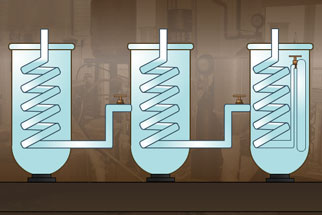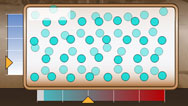Reaching Ultra-Low Temperatures
- By Richard Pommier Swanson
- Posted 01.08.08
- NOVA
Pioneers in the quest to reach absolute zero relied on a technique known as the "cascade" process. By repeating a certain sequence that involved the cooling, compression, and evaporation of various liquids and gases, scientists approached ever closer to absolute zero, the lowest possible temperature. In this interactive, undertake your own three-step cascade and see if you can choose the right combination of gases to liquefy oxygen.
 Launch Interactive
Launch Interactive
In our virtual chemistry lab, use the "cascade" process to achieve dramatically lower temperatures.
This feature originally appeared on the site for the NOVA program Absolute Zero.
Credits
Images
- (all)
- ©2007 Meridian Productions and Windfall Films
Related Links
-

Ultracold Atoms
What is a Bose-Einstein condensate? Physicist Luis Orozco gets into the nitty-gritty of this very, very cold substance.
-

States of Matter
In this interactive, adjust temperature and pressure, and watch gases become liquids, liquids become solids, and more.
-

Absolute Hot
Is there an opposite to absolute zero, the lowest possible temperature?
-

Absolute Zero
The story of the harnessing of cold and the race to reach the lowest temperature possible
You need the Flash Player plug-in to view this content.

